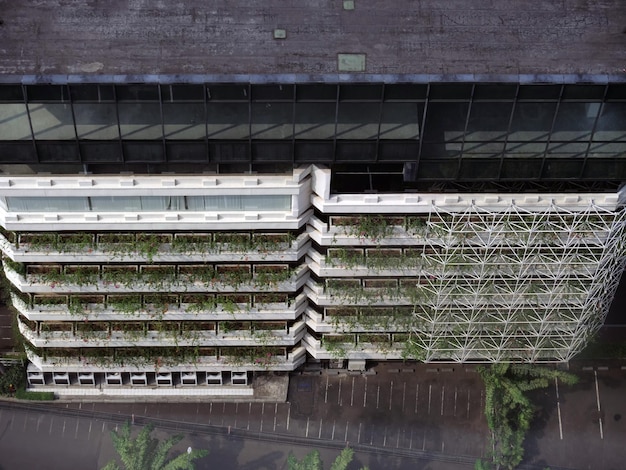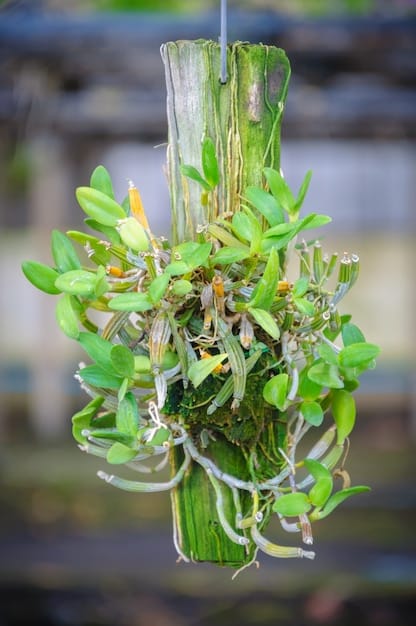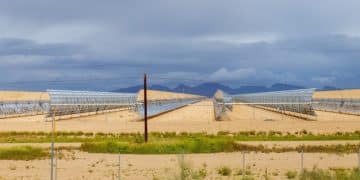Vertical Farming Potential for Sustainable Urban Food Production in the US

Exploring the potential of vertical farming for sustainable food production in urban areas of the US reveals innovative solutions to address food security, environmental concerns, and resource efficiency through controlled-environment agriculture.
The concept of exploring the potential of vertical farming for sustainable food production in urban US areas is rapidly gaining traction as cities grapple with increasing populations, limited agricultural land, and the urgent need for environmentally friendly food sources. Vertical farming, with its promise of high yields in controlled environments, may offer a path toward greater food security and resilience in the face of climate change.
Understanding Vertical Farming: An Overview
Vertical farming represents a significant shift in agricultural practices, moving away from traditional, land-intensive methods to controlled-environment agriculture (CEA). This innovative approach involves growing crops in vertically stacked layers, often indoors, using techniques such as hydroponics, aeroponics, and aquaponics.
By controlling environmental factors like temperature, humidity, light, and nutrient delivery, vertical farms can optimize growing conditions, leading to higher yields, reduced water usage, and minimized pesticide application.
Key Components of Vertical Farming Systems
Vertical farming systems typically include several key components that work together to create an optimal growing environment:
- Physical Structure: Multi-layered structures that maximize space utilization.
- Lighting: LED lighting systems tailored to specific plant needs.
- Environmental Control: HVAC systems, temperature, and humidity sensors.
Benefits and Challenges of Vertical Farming
While vertical farming offers numerous benefits, it is essential to acknowledge the challenges associated with its implementation:
- Benefits: Higher yields, Year-round production, Reduced water usage
- Challenges: High initial investment, Energy consumption, Limited crop variety

In conclusion, vertical farming presents a compelling vision for the future of agriculture, offering a potential solution to address the challenges of food security and sustainability in urban environments. By understanding the key components, benefits, and challenges associated with this technology, we can better assess its potential to transform food production.
The Role of Vertical Farming in Urban Food Security
Urban food security is a growing concern as cities face increasing populations and limited access to fresh, nutritious food. Vertical farming offers a unique opportunity to enhance food security by producing crops locally, reducing transportation costs, and ensuring a consistent supply of fresh produce.
By locating vertical farms within urban centers, cities can reduce their reliance on distant agricultural regions, shorten supply chains, and provide their residents with access to locally grown food.
Enhancing Access to Fresh Produce
One of the most significant benefits of vertical farming is its ability to provide urban residents with access to fresh, locally grown produce:
- Reduced Transportation: Vertical farms can be located in urban areas, minimizing transportation distances.
- Year-Round Production: Controlled environments allow for continuous crop production.
- Nutritional Value: Locally grown produce retains more nutrients due to reduced transit times.
Addressing Food Deserts in Urban Areas
Vertical farming can play a crucial role in addressing food deserts, which are areas where residents have limited access to affordable and nutritious food:
- Local Production: Establishing vertical farms in food deserts can supply residents with fresh produce.
- Job Creation: Vertical farms can create local employment opportunities.
- Community Engagement: Vertical farming projects can engage residents in food production.
In conclusion, vertical farming has the potential to revolutionize urban food systems, providing cities with a sustainable and resilient source of fresh produce. By enhancing access to nutritious food and addressing food deserts, vertical farming can contribute to improved public health and community well-being in urban areas.
Environmental Benefits of Vertical Farming
Beyond its potential to enhance food security, vertical farming offers numerous environmental benefits, including reduced water usage, minimized pesticide application, and decreased carbon emissions. These advantages make vertical farming a compelling solution for sustainable agriculture in urban areas.
By adopting vertical farming practices, cities can reduce their environmental footprint and promote more sustainable food production systems.
Reducing Water Consumption in Agriculture
Traditional agriculture is a water-intensive industry, often relying on irrigation methods that can deplete water resources. Vertical farming significantly reduces water consumption through:
- Closed-Loop Systems: Water is recycled and reused within the farm.
- Targeted Irrigation: Water is delivered directly to plant roots.
- Reduced Evaporation: Controlled environments minimize water loss through evaporation.
Minimizing Pesticide and Herbicide Application
Vertical farms operate in controlled environments, which reduces the need for pesticides and herbicides:
- Controlled Environment: pests and diseases are minimized in the controlled environment.
- Integrated Pest Management: biological controls are used to manage pests and diseases.
- Reduced Chemical Use: elimination of chemical use protects the environment and human health.
Decreasing Carbon Emissions from Transportation
By locating vertical farms within urban areas, we can reduce the carbon emissions associated with transporting food from distant agricultural regions:
- Localized Production: Produce is grown near consumers, shortening the supply chain.
- Reduced Transportation: Lower fuel consumption and emissions due to less travel.
- Improved Food Quality: fresher produce with a longer shelf life due to reduced transport times.

In conclusion, the environmental benefits of vertical farming are substantial, presenting a compelling case for its adoption in urban areas. By reducing water usage, minimizing pesticide application, and decreasing carbon emissions, vertical farming offers a path toward more sustainable and environmentally friendly food production systems, making it a vital component of urban sustainability initiatives.
Economic Viability and Investment in Vertical Farming
While the concept of vertical farming holds immense promise, its economic viability is a critical factor in its widespread adoption. Understanding the costs, benefits, and potential return on investment is essential for attracting investment and ensuring the long-term sustainability of vertical farming projects.
Evaluating the economic aspects of vertical farming requires a comprehensive analysis of operational expenses, market demand, and technological advancements.
Initial Investment Costs and Operational Expenses
Setting up a vertical farm involves significant upfront investment in infrastructure, technology, and equipment:
- Infrastructure: cost of constructing the multi-layered structure and supporting facilities.
- Technology: high expenses on LED lighting, climate control systems, and automation.
- Equipment: costs of hydroponic systems, aeroponic systems, sensors, and monitoring devices.
Market Demand and Pricing Strategies
To achieve economic viability, vertical farms must cater to market demand and implement effective pricing strategies:
- Market research: identifying the target audience, products, and distribution channels.
- Competitive Pricing: offering competitive pricing reflecting the produce’s value and sustainability.
- Branding and Marketing: differentiating products through the high quality and environmental benefits.
Government Policies and Incentives
Government support for vertical farming projects can significantly contribute to their economic success:
- Subsidies and grants: providing seed funding and financial assistance.
- Tax incentives: offering tax rebates and deductions for vertical farming investments.
- Regulatory support: streamlining the permitting process and creating favorable policies.
In conclusion, the economic viability of vertical farming hinges on careful planning, efficient management, and strategic partnerships. By understanding the costs involved, catering to market demand, and leveraging government support, vertical farming projects can establish a solid economic foundation and contribute to a more sustainable food system in urban areas.
Technological Innovations Driving Vertical Farming
Technological advancements have played a crucial role in the evolution of vertical farming, enabling more efficient, sustainable, and scalable operations. From advanced lighting systems to automated growing technologies, these innovations are transforming the way we produce food in urban environments.
Exploring these technological innovations is essential to understand the future potential and optimize the performance of vertical farms.
LED Lighting Systems for Optimized Plant Growth
LED lighting systems are a key component of modern vertical farms, providing tailored light spectra that enhance plant growth and yield:
- Customized Light Spectra: LEDs can be programmed to emit specific light wavelengths.
- Energy Efficiency: LEDs consume significantly less energy than traditional lighting.
- Reduced Heat Emission: LEDs produce less heat, minimizing the need for costly cooling.
Automated Growing and Monitoring Technologies
Automation technologies streamline various aspects of vertical farming, reducing labor costs and improving efficiency:
- Automated Planting and Harvesting: robotic system for precise and rapid planting and harvesting.
- Sensor-Based Monitoring: real-time monitoring of environmental conditions.
- Data Analytics: analyzing data to optimize growing conditions and resource utilization.
Hydroponics, Aeroponics, and Aquaponics Systems
These soil-less growing methods are fundamental to vertical farming, offering efficient nutrient delivery and water usage:
- Hydroponics: plants grow in nutrient-rich water solutions without soil.
- Aeroponics: roots are suspended in the air and sprayed with nutrient solutions.
- Aquaponics: integrates aquaculture, raising fish, with hydroponics, using nutrient-rich water for plant growth.
In conclusion, technological innovations are revolutionizing vertical farming, making it more efficient, sustainable, and economically viable. By embracing these advancements, vertical farms can optimize their operations, produce higher yields, and contribute to a more resilient and environmentally friendly food system in urban areas.
Challenges and Future Directions for Vertical Farming in the US
Despite its numerous benefits and technological advancements, vertical farming faces several challenges that must be addressed to achieve its full potential in the US. These challenges range from regulatory hurdles to public perception, and overcoming them is crucial for the widespread adoption of vertical farming.
Addressing these challenges while exploring future directions will pave the way for a more sustainable and resilient food system in urban areas.
Regulatory and Policy Frameworks
Establishing supportive regulatory and policy frameworks is essential for promoting vertical farming in the US. Currently, the sector faces:
- Permitting Issues: Navigating local zoning laws and permitting processes can be challenging.
- Food Safety Standards: Ensuring compliance with food safety regulations.
- Energy Consumption Regulations: Addressing greenhouse gas emissions related to energy usage.
Consumer Awareness and Acceptance
Increasing the consumer awareness and acceptance of vertically farmed produce is crucial for driving market demand:
- Educating Consumers: Informing consumers about the benefits of vertically farmed produce
- Branding Strategies: Highlighting the nutritional benefits and sustainable practices.
- Building trust by transparent information about the sustainability practices and quality assurance.
Research and Development Priorities
Continued research and development efforts are needed to optimize growing practices, improve energy efficiency, and expand the range of crops suitable for vertical farming:
- Crop Diversification: developing efficient methods for growing a broader range of crops.
- Energy-Efficient Technologies: seeking out more sustainable energy sources like LEDs and renewable energy.
- Data-Driven Optimization: Collecting and utilizing data to improve growing practices
In conclusion, addressing the challenges and exploring future directions for vertical farming in the US is crucial for realizing its full potential. By establishing supportive regulatory frameworks, raising consumer awareness, and prioritizing research and development, we can pave the way for more sustainable and resilient food systems in urban areas, contributing to a healthier and more environmentally responsible future.
| Key Point | Brief Description |
|---|---|
| 🌱 Urban Food Security | Vertical farms enhance local food accessibility, crucial for urban areas. |
| 💧 Water Conservation | Vertical farming significantly reduces water use through recycling. |
| 💡 LED Innovation | Customized LEDs optimize plant growth in controlled environments. |
| 💰 Economic Hurdles | High initial costs necessitate government and private support. |
Frequently Asked Questions
▼
Vertical farming is a method of growing crops in vertically stacked layers, often indoors, using controlled-environment agriculture (CEA) techniques, such as hydroponics, aeroponics, or aquaponics.
▼
Main advantages include higher yields, reduced water usage, minimized pesticide application, year-round production, and localized food production, which can enhance urban food security.
▼
Vertical farming reduces water consumption through closed-loop systems, minimizes pesticide use by controlled environments, and decreases carbon emissions through localized production and shorter supply chains.
▼
The primary challenges include high initial investment costs, regulatory hurdles, consumer awareness and acceptance, and the need for continued research and development to improve efficiency.
▼
The future of vertical farming in urban areas is promising, with ongoing technological innovations, supportive government policies, and increasing consumer demand driving its growth and broader adoption.
Conclusion
In summary, exploring the potential of vertical farming for sustainable food production in urban US areas showcases a transformative approach to agriculture that addresses critical challenges related to food security, environmental sustainability, and resource management. While challenges remain, technological innovations and strategic investments are paving the way for a more resilient and environmentally responsible food system.





